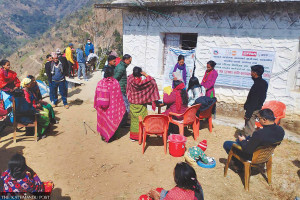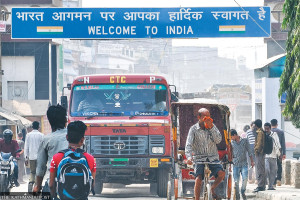 19.12°C Kathmandu
19.12°C KathmanduColumns
Heritage of Nepali portrait paintings
Art historians and scholars should take up the cudgel to locate the portraits here and abroad.
Abhi Subedi
Portrait making in Nepal, which also shares some universal features, has an important history. The heritage of portrait painting executed by using modern techniques is not very old in Nepal. For heuristic purpose, I want to begin with a modern example. Art historian and critic Dina Bangdel writes how Lain Singh Bangdel went through several attempts and experiments to make BP Koirala’s portrait finally. In her book Lain Bangdel: Fifty Years of His Art (1995), Dina writes, “The portrait captures vividly the sitter’s dynamic personality while the swift brushwork and warm colours, combined with an abstraction give the painting a sense of arrested movement.” Anyone who goes to the gallery of the Nepal Arts Council can see BP Koirala’s portrait with “arrested movement” placed alongside those of other politicians and literary writers.
Art reviewers and historians have written about the Nepali heritage of portrait making of kings and courtiers by using the techniques of Indian art. My interest is in portrait making in Nepal after the exposure of Nepali painters to Western techniques in terms of figurality and colour expressions. This short essay has its limitations; I cannot discuss the subject in detail. What can be said is that there is a tradition of portrait making in Nepal, and artists had executed them even before Chandra Man Maskey and Tej Bahadur Chitrakar got modern education in Calcutta in the very early years of the 20th century. But where to go and see Nepali portrait paintings is a very difficult question to answer. It is clear, no galleries, and with some exceptions, no museums hold them. It is widely believed that some Rana families, the erstwhile royals, and the Chitrakars, who were court painters, hold them.
Portrait paintings
I saw a number of portraits executed by the late Balkrishna Sama, the doyen of modern Nepali drama and a painter, when I visited his house quite frequently many years ago. Painter Chandra Man Maskey showed some paintings and narrated his experience about executing portraits including that of King Tribhuvan about which I have published an article titled “Chandraman Maskey and Tribhuvan’s moustache” in Kantipur (December 19, 2020). Amar Chitrakar, a great portraitist and sculptor, executed the images of the Shah kings and some of their families. They can be seen in museums, and some are at the Memorial Building of Tribhuvan University. I saw some portrait paintings at big exhibitions of works by painters like Lain Singh Bangdel at the Nepal Arts Council.
To dwell more on the Nepal Arts Council, I want to recall a recent incident. An invitation from Arts Nepal to visit an art exhibition under a familiar nomenclature “Himalayan Art Festival” held from August 24-30, 2023 at the Nepal Art Council had a special attraction for me. The subtitle “Exhibition of the finest collection of Nepali Arts” drew me to the exhibition. This was the second announcement of this nature. The previous one held in November-December 2022 had also said that paintings from the holdings of different individuals and art lovers would be loaned for the exhibition. The reason for my expectation is that despite a strong tradition of portrait paintings in Nepal, it is difficult to see them. That is the reason why I rushed to the exhibition to see if some early portrait paintings would be on display. But there were none.
There are a few individuals who would have some knowledge about such portrait paintings. Among them is the famous curator and art critic Sangeeta Thapa of the Siddhartha Art Foundation. She is an art curator of special order and a member of the family of the Ranas who are believed to hold such paintings in their collections. But I have not communicated with art curators and galleries about this subject. I have an interesting experience of sharing information regarding such paintings. In the early years of the Eighties, a British Nepali historian John Whelpton came to Nepal for his PhD research on Jang Bahadur Rana. He also had a book entitled Jang Bahadur in Europe, an English translation of the Nepali text about Jang’s visit to Britain and France ready for publication at Sahayogi Press in Kathmandu.
We were looking for some images to go into that book. In that connection, we went to the house of a very charming, intelligent and senior art lover and friend MK Rana alias Mousuri Shumsher Rana who had told us that he had a collection of portrait paintings of Jang Bahadur and his family members executed by Bhajuman Chitrakar who had accompanied Jang to Europe in his visit of 1850. That sounded like a treasure trove. MK’s lovely house was perched on a small height to the immediate north of today’s Maitighar. There were portraits of Jang, his father and some other men of his family. It was exciting to see them. My part was to take their photos with a good camera that John had hired from London University for the purpose of his research. Some of those photos are included in the book that came out in 1983.
After MK’s death that occurred after some years, it can be assumed the paintings would have been removed; the house also did not remain in the same shape and place. Curious and a little worried, I told Sangeeta Thapa about the portrait paintings of Bhajuman. She was naturally very worried too. But after several years, one day a relieved Sangeeta Thapa told me, “The paintings are safe and this is a great day for Nepali art.” I was overjoyed. That was the last time we talked about those historical portraits. But that was an important moment.
People with power
We should look at the heritage of portrait making by linking it to power. The subjects of portraits were royalties or nobilities, which is more or less the practice everywhere. Their portraits, mostly done in oil, were on the walls of power and administration. But where these portraits go or are placed or dumped now is difficult to say. But portraits speak volumes about power, pelf and even isolation. One can see some of those features in the portraits of royal women at the Narayanhiti Museum today. Portraits of quiet and benign looking women can be contrasted with the arrogant and a little bland portraits of men in power.
Through this article, I would like to call upon art curators and individual collectors to come together and organise an exhibition of portraits. To trace the heritage of portrait making in Nepal, art historians and scholars should take up the cudgel to locate the portraits here and abroad, and see how they can be loaned for exhibition. Like some previous exhibitions of a similar nature, this one too will be an important display of Nepali art.



















